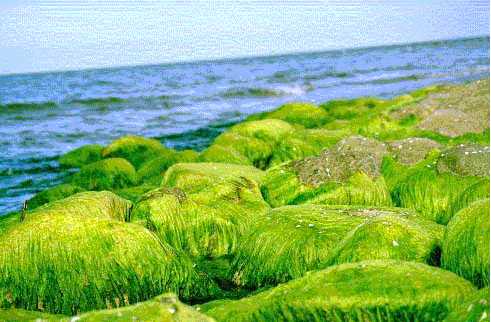


 |  |  | 19.5 The Gulf is basically nitrogen-limited |
The total nutrient pools in the Gulf of Riga show significant seasonal changes. Springtime levels of ca. 400 mug N l-1 and 30 mug P l-1 in the whole basin (1995) except for the southern River Daugava plume, where concentrations of >>600 mug N l-1 and up to 40 mug P l-1 have been detected. During the summer stages, total nutrient pools levels are lowest (on average, 270 mug N l-1 and 17 mug P l-1 in June 1994), increasing slightly from midsummer and onwards [456]. The annual cycle of total nutrients with maximum in spring, minimum in early summer and gradual increase towards autumn is well established for adjacent Baltic areas like the Gulf of Finland, and overall total nutrient levels were comparable to long-term data from the coastal areas of the middle and eastern Gulf of Finland [227]. Thus the total nutrient pools of the Gulf of Riga indicate a rather similar overall degree of eutrophy as other Baltic subareas.
The early spring 1995 nutrient distributions clearly indicated that the spring bloom period in the Gulf of Riga is potentially N-limited, since during the homothermal and deep-mixing season, inorganic N/P ratios were markedly and uniformly below the Redfield ratio in the whole basin, with the exception of the River Daugava plume [456]. In early summer 1994, the mixed surface layer was effectively depleted of inorganic nutrients (both phosphate, nitrate and ammonium), yielding low (<Redfield) inorganic N/P ratios, except for the southernmost basin, which had high ammonium levels because of a strong mixing event. In mid-July 1994, very low inorganic nutrient concentrations and very low inorganic N/P ratios prevailed over the whole Gulf in the surface layer. Under this strongly N-limited productive layer, cumulative mineralization of ammonium and phosphate took place in the relatively warm intermediate layers, as well as near to the bottom. A strongly N-limited productive layer, and equally strongly N-surplus deeper strata below the mixed layer characterize the summer stages in the Gulf of Riga as long as distinct separation of these layers prevail [456].
It is obvious that physical mixing events can produce drastic temporary fluctuations in the limitation pattern by introducing the significant nitrogen reserves from deeper water into the euphotic zone. When the effectively mixed surface layer depth exceeds significantly the depth of the euphotic zone towards the end of the stratified period, the production preconditions of planktonic autotrophs deteriorate, and consequently so do their capacity to utilise the nutrient pool of the mixed surface layer. As the considerable accumulations of nutrients in deep layers are also mixed into the surface layer, a combined result could be a sharp increase of inorganic nutrients in the euphotic zone.
Deep mixing during the stratified period promotes P-limitation, whereas a thin or moderate mixed layer promotes N-limitation, as previously observed in the outer estuary of the River Neva, eastern Gulf of Finland [374]. During the stratified period, strong mixing events due to physical forcing can abruptly change the prevailing N limitation into a P-limited phase, but unless deep mixing is prolonged, N-limitation is likely to be re-established in the surface layer. The probability of P-limited phases should increase towards the end of the stratified season, both due to the hydrographical development towards deep mixing, and to cumulative increase of subthermocline N reserves. The Gulf of Riga appears therefore to be characterized by considerable, hydrographically driven interannual and within-season variability with regard to surface layer inorganic nutrient concentrations and limitation patterns, in spite of the essential N limitation of the basin. The limitation scenario suggested by Tamminen and Seppälä [456], which contradicts the conclusions of Yurkovskis et al. [505] and Suursaar [449] suggesting P limitation of the Gulf, is supported by experimental evaluation of nutrient limitation of the natural planktonic communities [419].

 |  |  | 19.5 The Gulf is basically nitrogen-limited |